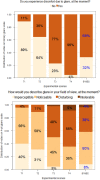Influence of macular pigment on the sensitivity to discomfort glare from daylight
- PMID: 37899478
- PMCID: PMC10613614
- DOI: 10.1038/s41598-023-45785-x
Influence of macular pigment on the sensitivity to discomfort glare from daylight
Abstract
Understanding the factors that influence the human perception of glare is necessary to properly address glare risks in buildings and achieve comfortable visual environments, especially in the workplace. Yet large inter-individual variabilities in glare perception remain unexplained and thus uncovered by the current empirical glare models. We hypothesize that this variability has an origin in the human retina, in particular in the density of macular pigments present in its central area, which varies between individuals. Macular pigments are known to absorb blue light and attenuate chromatic aberration, thus reducing light scatter. This study presents the outcomes of the first experiment ever conducted in a daylit office environment, in which glare sensitivity and macular pigment density were measured and compared for 110 young healthy individuals, along with other ocular parameters. The participants were exposed to different glare conditions induced by the sun filtered through either color-neutral or blue-colored glazing. In neutral daylight conditions with sun disc in the near periphery, neither macular pigment nor any other investigated ocular factors have an impact on discomfort glare perception whereas glare perception in conditions with the blue-colored sun disc in the near periphery was found to be correlated with macular pigment optical density.
© 2023. The Author(s).
Conflict of interest statement
The authors declare no competing interests.
Figures







Similar articles
-
A double-blind, placebo-controlled study on the effects of lutein and zeaxanthin on photostress recovery, glare disability, and chromatic contrast.Invest Ophthalmol Vis Sci. 2014 Dec 2;55(12):8583-9. doi: 10.1167/iovs.14-15573. Invest Ophthalmol Vis Sci. 2014. PMID: 25468896 Clinical Trial.
-
The glare hypothesis of macular pigment function.Optom Vis Sci. 2007 Sep;84(9):859-64. doi: 10.1097/OPX.0b013e3181559c2b. Optom Vis Sci. 2007. PMID: 17873771
-
Macular pigment spatial distribution effects on glare disability.J Optom. 2015 Oct-Dec;8(4):258-65. doi: 10.1016/j.optom.2014.12.004. Epub 2015 Feb 16. J Optom. 2015. PMID: 25697374 Free PMC article.
-
Macular pigment: a review of current knowledge.Arch Ophthalmol. 2006 Jul;124(7):1038-45. doi: 10.1001/archopht.124.7.1038. Arch Ophthalmol. 2006. PMID: 16832030 Review.
-
The association between macular pigment optical density and visual function outcomes: a systematic review and meta-analysis.Eye (Lond). 2021 Jun;35(6):1620-1628. doi: 10.1038/s41433-020-01124-2. Epub 2020 Aug 13. Eye (Lond). 2021. PMID: 32792595 Free PMC article.
References
-
- Boyce, P., Hunter, C. & Howlett, O. The Benefits of Daylight through Windows. vol. 1 (2003).
-
- Leather P, Pyrgas M, Beale D, Lawrence C. Windows in the workplace: Sunlight, view, and occupational stress. Environ. Behav. 1998;30:739–762. doi: 10.1177/001391659803000601. - DOI
-
- Day JK, et al. Blinded by the light: Occupant perceptions and visual comfort assessments of three dynamic daylight control systems and shading strategies. Build. Environ. 2019;154:107–121. doi: 10.1016/j.buildenv.2019.02.037. - DOI
-
- Hemphälä, H., Heiden, M., Lindberg, P. & Nylén, P. Visual symptoms and risk assessment using visual ergonomics risk assessment method (VERAM). In Proceedings of the 21st Congress of the International Ergonomics Association (IEA 2021) 729–735 (Springer International Publishing, 2021) 10.1007/978-3-030-74605-6_92.
-
- CIE. Discomfort Glare in the Interior Working Environment. 52 (1983).

